| Features: Places and events |  |
Creating a wildflower meadow: talk and tour at Bluebell Cottage Gardens, CheshireBluebell Cottage Gardens specialises in cottage garden plants and they are shown off to spectacular effect in the extensive grounds. Also adjacent the nursery is the three acre wildflower meadow and a two-and-a-half acre natural woodland. In 2003, the nursery, gardens, meadow and woodland were managed and cared for by a small family business headed by Rod and Diane Casey. (Since April 2005 the business has been owned and run by Jack and Anne Stewart.) For a number of years the gardens hosted Royal Horticultural Society events to give people the chance to discover how the wildflower meadow was created and to participate in a guided tour.
I attended one of these events on 12th June 2003. It was a memorable afternoon helped by glorious June weather. The afternoon began with an illustrated talk by Rod on the creation of and maintenance of the wildflower meadow. The venue for this was a large timber building in the grounds of the nursery and it was pretty well packed with perhaps 40 or so people. After the talk came a tour of the meadow and Bluebell Cottage gardens and then we were all invited to join Rod and Diane for tea and scones. Afterwards many people took the opportunity to view and purchase plants from the nursery. Both Rod and Diane were open to questions over the course of the afternoon. Rod's account of the creation of the meadow was frank and informative. The rest of this feature is the product of what I
saw and learned about creating and maintaining a wildflower meadow over the course of the afternoon.
The wildflower meadow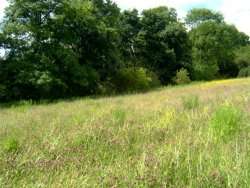 My first view of the meadow.(View bigger image.)
At three acres, the wildflower meadow is much bigger than the vast majority of us can aspire to, but My first view of the meadow.(View bigger image.)
At three acres, the wildflower meadow is much bigger than the vast majority of us can aspire to, but  many of the principles of assessment, creation and management are the same regardless of the size of the site many of the principles of assessment, creation and management are the same regardless of the size of the site many of the principles of assessment, creation and management are the same regardless of the size of the site. One thing to bear in mind is that managing a three acre meadow requires a well planned and methodical approach: mistakes on that scale can be both costly and time consuming. In the small plots of a few metres square that most of us will pass off as a 'wildflower meadow' in our gardens, we can usually afford to be more casual and experimental: mistakes are not going to be so expensive or time-consuming to put right. many of the principles of assessment, creation and management are the same regardless of the size of the site. One thing to bear in mind is that managing a three acre meadow requires a well planned and methodical approach: mistakes on that scale can be both costly and time consuming. In the small plots of a few metres square that most of us will pass off as a 'wildflower meadow' in our gardens, we can usually afford to be more casual and experimental: mistakes are not going to be so expensive or time-consuming to put right.
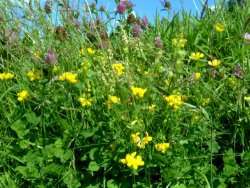 Bird's foot trefoil (Lotus corniculatus) growing in the meadow. (View bigger image.)
One of the first points that Rod Casey was keen to stress in his illustrated talk, which he gave before the tour, was that the meadow, which he termed a 'perennial wildflower meadow', is not what many expect of a wildflower meadow. Lots of people imagine a wildflower meadow as a riot of colour, typified by flowers such as the field poppy (Papaver rhoeas). But in fact, the poppy and other associated plants like corncockle (Agrostemma githago) and corn marigold (Crysanthemum segetum) are actually annuals which thrive in the disturbed margins of arable fields: they are not true meadow flowers at all. Bird's foot trefoil (Lotus corniculatus) growing in the meadow. (View bigger image.)
One of the first points that Rod Casey was keen to stress in his illustrated talk, which he gave before the tour, was that the meadow, which he termed a 'perennial wildflower meadow', is not what many expect of a wildflower meadow. Lots of people imagine a wildflower meadow as a riot of colour, typified by flowers such as the field poppy (Papaver rhoeas). But in fact, the poppy and other associated plants like corncockle (Agrostemma githago) and corn marigold (Crysanthemum segetum) are actually annuals which thrive in the disturbed margins of arable fields: they are not true meadow flowers at all.
 A true perennial wildflower meadow forms a more stable ecosystem (though not static) and the colours tend to be more subdued A true perennial wildflower meadow forms a more stable ecosystem (though not static) and the colours tend to be more subdued Of course you can grow these in your garden, but you will have to emulate the conditions to which they are adapted by cultivating your soil annually. A true perennial wildflower meadow forms a more stable ecosystem (though not static) and the colours tend to be more subdued; generally smaller flower-heads set amongst shades of green and yellow of the foliage, associated grasses etc. The greater structural variety and permanence of a perennial wildflower meadow makes it, in general, a better habitat for encouraging biodiversity.
Of course you can grow these in your garden, but you will have to emulate the conditions to which they are adapted by cultivating your soil annually. A true perennial wildflower meadow forms a more stable ecosystem (though not static) and the colours tend to be more subdued; generally smaller flower-heads set amongst shades of green and yellow of the foliage, associated grasses etc. The greater structural variety and permanence of a perennial wildflower meadow makes it, in general, a better habitat for encouraging biodiversity.
 when Rod and Diane Casey decided to turn the land into a perennial meadow in 1994, they were among the pioneers of this kind of naturalistic horticulture when Rod and Diane Casey decided to turn the land into a perennial meadow in 1994, they were among the pioneers of this kind of naturalistic horticulture Prior to 1994 the site of the meadow was agricultural land. Nowadays wildflower meadows, like wildlife gardens in general, are very much in vogue; but when Rod and Diane Casey decided to turn the land into a perennial meadow in 1994, they were among the pioneers of this kind of naturalistic horticulture. The rest of this feature describes what they did, what they learned and what lessons we can draw from it. Much of the information comes directly from the talk which Rod Casey gave on the day, but any mistakes are my own! Prior to 1994 the site of the meadow was agricultural land. Nowadays wildflower meadows, like wildlife gardens in general, are very much in vogue; but when Rod and Diane Casey decided to turn the land into a perennial meadow in 1994, they were among the pioneers of this kind of naturalistic horticulture. The rest of this feature describes what they did, what they learned and what lessons we can draw from it. Much of the information comes directly from the talk which Rod Casey gave on the day, but any mistakes are my own!
Assessing the site
Before creating a wildflower meadow, you need to make an assessment of your site. What you find will determine a number of things including;
- your overall strategy for creating the meadow,
- how you prepare the site,
- what plants you introduce or sow there.
You must also take into account all the usual factors considered when planting in a garden, e.g. the soil type, wetness and the amount of light available. In general, sites with plenty of light are more amenable to meadow creation, but if you do have a shady site, you can try to emulate the communities that occur in similar conditions in nature (e.g. woodland edge/glade and hedgerow bottom). If your site is wet, you will need to consider planting or sowing species which prefer damp conditions naturally. Seed mixes and plants to suit most conditions are available from good suppliers (e.g. Landlife Wildflowers and Emorsgate Wild Seeds). The important thing is to make an effort to understand what will do well in your conditions before you buy.
Apart from the normal considerations, there is one other exceedingly important factor that needs to be considered when planning a meadow: soil fertility.  In contrast to the horticultural requirements of many garden plantings, for a perennial wildflower meadow, you require low fertility In contrast to the horticultural requirements of many garden plantings, for a perennial wildflower meadow, you require low fertility In contrast to the horticultural requirements of many garden plantings, for a perennial wildflower meadow, you require low fertility. In this respect a meadow is similar to a pond. If you have a pond, you will be familiar with the problems caused by too many nutrients in the water: fast growing algae tend to dominate at the expense on the plants you really want to thrive. In the meadow, high fertility encourages rapid growth of the rank grasses which will rapidly shade out the finer grasses and plants which you would prefer to see. In contrast to the horticultural requirements of many garden plantings, for a perennial wildflower meadow, you require low fertility. In this respect a meadow is similar to a pond. If you have a pond, you will be familiar with the problems caused by too many nutrients in the water: fast growing algae tend to dominate at the expense on the plants you really want to thrive. In the meadow, high fertility encourages rapid growth of the rank grasses which will rapidly shade out the finer grasses and plants which you would prefer to see.
If your site is just a small grassed area in your garden, why not leave the grass uncut for a few months in summer: you'll soon get an idea of what the soil fertility is like from the rate at which the grass grows and what other plants you find there. If you cannot gauge your soil fertility from your experience of what already grows there, you might want to get it tested properly. This could involve sending a sample to an organisation like the Royal Horticultural Society.  In the worse, case scenario, where soil fertility is very high, you will need to take steps to reduce it In the worse, case scenario, where soil fertility is very high, you will need to take steps to reduce it In the worse, case scenario, where soil fertility is very high, you will need to take steps to reduce it. If your site is reasonably small, you could simply remove the most fertile topsoil. Other methods for reducing fertility include growing nutrient hungry plants like potatoes, turnips or green manure crops for a year or two and removing all the produce away from the site. In the worse, case scenario, where soil fertility is very high, you will need to take steps to reduce it. If your site is reasonably small, you could simply remove the most fertile topsoil. Other methods for reducing fertility include growing nutrient hungry plants like potatoes, turnips or green manure crops for a year or two and removing all the produce away from the site.
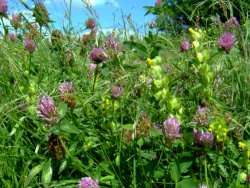 Yellow rattle (Rhinanthus minor) with red clover (Trifolium pratense) in the sward of the meadow. (View bigger image.)
On sites of both high and medium fertility, the best course of action is to eradicate the existing vegetation and sow with new plants; otherwise the existing plants, which will be adapted to the high fertility, will just out-compete anything you put in with them. On sites with low fertility, you have the option of 'improving' what is already there rather than starting again. On a small site of low fertility, this is an ideal option; probably less expensive overall and certainly a lot less work.
To improve a meadow in this way, all you need to do is to introduce the plants you want as plugs or pot-grown plants. Sowing seed into an existing sward is rarely an effective option. The one plant which is a possible exception to this rule is yellow rattle (Rhinanthus minor). Yellow rattle (Rhinanthus minor) with red clover (Trifolium pratense) in the sward of the meadow. (View bigger image.)
On sites of both high and medium fertility, the best course of action is to eradicate the existing vegetation and sow with new plants; otherwise the existing plants, which will be adapted to the high fertility, will just out-compete anything you put in with them. On sites with low fertility, you have the option of 'improving' what is already there rather than starting again. On a small site of low fertility, this is an ideal option; probably less expensive overall and certainly a lot less work.
To improve a meadow in this way, all you need to do is to introduce the plants you want as plugs or pot-grown plants. Sowing seed into an existing sward is rarely an effective option. The one plant which is a possible exception to this rule is yellow rattle (Rhinanthus minor).  Yellow rattle is partially parasitic on the roots of grasses and may establish well from seed sown into an existing sward Yellow rattle is partially parasitic on the roots of grasses and may establish well from seed sown into an existing sward Yellow rattle is partially parasitic on the roots of grasses and may establish well from seed sown into an existing sward. It has the huge advantage of weakening the grasses on which it feeds; thus improving the overall condition of the meadow. Yellow rattle is partially parasitic on the roots of grasses and may establish well from seed sown into an existing sward. It has the huge advantage of weakening the grasses on which it feeds; thus improving the overall condition of the meadow.
In the Bluebell Cottage meadow, the soil was of medium fertility and the decision was taken to kill off all the existing vegetation and start from scratch. The next few sections of this feature deal with this strategy of meadow creation.
Preparing the site
The first task is to kill all the plants which currently occupy the site. If you have a very small site, you may just be able to accomplish this by lifting the turf, or whatever plants are there, by hand. Otherwise, a systemic herbicide can be used. Systemic herbicides work by being absorbed through the foliage and into the plants system.  If you do plan to use a herbicide, investigate it thoroughly and use an environmentally friendly one: a glyphosate based herbicide will become inactive on contact with the soil If you do plan to use a herbicide, investigate it thoroughly and use an environmentally friendly one: a glyphosate based herbicide will become inactive on contact with the soil If you do plan to use a herbicide, investigate it thoroughly and use an environmentally friendly one: a glyphosate based herbicide will become inactive on contact with the soil. If you do plan to use a herbicide, investigate it thoroughly and use an environmentally friendly one: a glyphosate based herbicide will become inactive on contact with the soil.
If you plan to sow seed and prepare the site by using a systemic herbicide, you should set aside a whole season to do the job. You may have to carry out three applications of the herbicide. The first application should be made around the beginning of May when the plants are actively growing. After ten days or so, you should see signs of dieback, and after around three weeks, the plants should be dead. The only way to check that they really are dead is to dig up samples and check the roots, which should not show any signs of life. If you home in on patches which are clearly not dead, now is the time to 'spot spray' them with a second application.
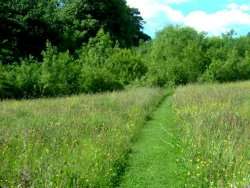 The meadow in 2003. Note the mown path (here leading to the bluebell wood). (View bigger image.)
After allowing some more time for the herbicide to do its job and checking its efficacy, you can clear all the dead vegetation away from the site. Now is the time to carry out any site preparation, e.g. levelling (if desired) and creation of a good seed bed. Make a decent fist of this now, because you will not be able to disturb the soil again after the next stage of site preparation. The meadow in 2003. Note the mown path (here leading to the bluebell wood). (View bigger image.)
After allowing some more time for the herbicide to do its job and checking its efficacy, you can clear all the dead vegetation away from the site. Now is the time to carry out any site preparation, e.g. levelling (if desired) and creation of a good seed bed. Make a decent fist of this now, because you will not be able to disturb the soil again after the next stage of site preparation.
Rod Casey did not perform the next stage of preparation and he considers that they were very lucky to 'get away with it'. What you need to do now is sit back and wait for the 'weeds' to grow back in your carefully prepared seed bed! All soil has a 'seed bank' just waiting for the competition to move out of the way and you will be creating the ideal conditions for them: their biological clocks signal 'all systems go' and up they come.  If you sow your wildflower meadow as soon as you've prepared the seed-bed, your plants will have to compete with all the less desirable incumbents If you sow your wildflower meadow as soon as you've prepared the seed-bed, your plants will have to compete with all the less desirable incumbents If you sow your wildflower meadow as soon as you've prepared the seed-bed, your plants will have to compete with all the less desirable incumbents. Rod Casey believes that they got away with it in this instance because of the nature of their site: in this previously arable land, the seed bank had probably become depleted over the years. If you sow your wildflower meadow as soon as you've prepared the seed-bed, your plants will have to compete with all the less desirable incumbents. Rod Casey believes that they got away with it in this instance because of the nature of their site: in this previously arable land, the seed bank had probably become depleted over the years.
Once the weed seed has germinated and begun to grow strongly, you can make another application of your systemic herbicide, or manually remove the weeds on a small site. This will probably be around July. Whatever method you use to kill these plants, you must now keep soil disturbance to a minimum, otherwise you risk bringing more seeds from the seed bank towards the surface where they can germinate. Once the all the weeds have germinated, been killed and removed, you are ready to sow your wildflower meadow.
Sowing and first year maintenance
The best time for sowing a wildflower meadow is probably in late summer/autumn, as this reflects what happens in nature, but you can also sow in spring if necessary. If you are working to the timetable described in the previous section, then an autumn sowing in the same year that you prepared the seed bed is the obvious choice.
You can obtain wildflower meadow mixes from a number of sources. It is best to use a reputable source where you can be confident of the provenance of the seed, e.g. Landlife Wildflowers and Emorsgate Wild Seeds. Sowing rates will usually be prescribed by the vendor and are normally in the region of 5 grams per square metre.  Seed should be 'bulked' up using a carrying agent like barely meal or fine sawdust to make sowing easier and more even Seed should be 'bulked' up using a carrying agent like barely meal or fine sawdust to make sowing easier and more even Seed should be 'bulked' up using a carrying agent like barely meal or fine sawdust to make sowing easier and more even. Ensure that seed and carrier are thoroughly mixed before you begin to sow. When broadcasting seed by hand, cast the seed from side to side over the area once and then turn through an angle of 90 degrees and repeat your actions. The roughly perpendicular lines of attack should produce a more even spread. Seed should be 'bulked' up using a carrying agent like barely meal or fine sawdust to make sowing easier and more even. Ensure that seed and carrier are thoroughly mixed before you begin to sow. When broadcasting seed by hand, cast the seed from side to side over the area once and then turn through an angle of 90 degrees and repeat your actions. The roughly perpendicular lines of attack should produce a more even spread.
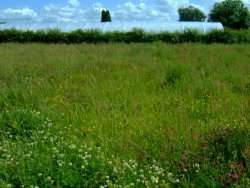 Another shot of the meadow in 2003. (View bigger image.)
Once broadcast, gentle pressure can be applied to ensure that seed is in firm contact with the soil, e.g. by using a light roller or by tamping down with the end of a rake or even your feet. Another shot of the meadow in 2003. (View bigger image.)
Once broadcast, gentle pressure can be applied to ensure that seed is in firm contact with the soil, e.g. by using a light roller or by tamping down with the end of a rake or even your feet.  Do not 'rake in' or otherwise disturb the seed bed, or you risk the germination of more weed seed from the seed bank which will compete with your plants Do not 'rake in' or otherwise disturb the seed bed, or you risk the germination of more weed seed from the seed bank which will compete with your plants Do not 'rake in' or otherwise disturb the seed bed, or you risk the germination of more weed seed from the seed bank which will compete with your plants. At this point, care is similar to the care you would give a newly sown lawn. In prolonged dry spells, you can water it if practical. You can use the normal methods for keeping birds off if you feel it's necessary. Do not 'rake in' or otherwise disturb the seed bed, or you risk the germination of more weed seed from the seed bank which will compete with your plants. At this point, care is similar to the care you would give a newly sown lawn. In prolonged dry spells, you can water it if practical. You can use the normal methods for keeping birds off if you feel it's necessary.
During the following season, the first full season for your meadow, you should adopt a specific management regime aimed at establishing the various species you have sown. Most of perennial meadow flowers will not flower until their second season and you want to encourage good root and basal growth of all the species you have sown. To do this,  cut the meadow to a height of about 5cm regularly over this first season cut the meadow to a height of about 5cm regularly over this first season cut the meadow to a height of about 5cm regularly over this first season. This allows light to get to the base of the plants and prevents the fastest establishing species from doing so at the expense of the others. Rod cut his meadow nine times during this first growing season. All cuttings should be removed from the meadow to keep fertility down allow light to get to the plants. Since none (or very few) plants will have flowered and set seed, there's nothing to be gained by leaving the cut plants on the meadow; they can be removed immediately. cut the meadow to a height of about 5cm regularly over this first season. This allows light to get to the base of the plants and prevents the fastest establishing species from doing so at the expense of the others. Rod cut his meadow nine times during this first growing season. All cuttings should be removed from the meadow to keep fertility down allow light to get to the plants. Since none (or very few) plants will have flowered and set seed, there's nothing to be gained by leaving the cut plants on the meadow; they can be removed immediately.
Aftercare
The second year proper is when your meadow will start to come into its own. Now you can let it grow and flower unmolested right through the spring and summer. You will need to patrol it for unwanted interlopers such as docks. When you find these, try to remove them with as much of their root as possible. As with all weeding, little and often is the best strategy. In all but the tiniest of meadows, it's a good idea to keep a mown path through it. Apart from looking very attractive, it will give you access to much of the meadow without having to trample the meadow itself.
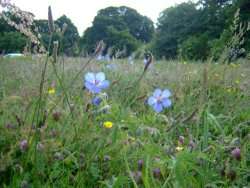 Meadow cransebill (Geranium pratense) introduced into the meadow. Some of these are now well enough established to be seeding themselves.(View bigger image.)
After a while, when you begin to get a feeling for which kind of plants thrive in your meadow and which do less well, Meadow cransebill (Geranium pratense) introduced into the meadow. Some of these are now well enough established to be seeding themselves.(View bigger image.)
After a while, when you begin to get a feeling for which kind of plants thrive in your meadow and which do less well,  you may wish to enrich your planting by 'injecting' pot grown plants you may wish to enrich your planting by 'injecting' pot grown plants you may wish to enrich your planting by 'injecting' pot grown plants. Very small plugs are unlikely to compete well with the established meadow plants, so beware of false economies and get the best you can afford. Because of the competition from extant meadow plants you should take even more care when planting into an established meadow than into a flower bed. Dig a good size hole for the plant you are introducing to ensure that it's given the best start - but remember, no fertilisers! you may wish to enrich your planting by 'injecting' pot grown plants. Very small plugs are unlikely to compete well with the established meadow plants, so beware of false economies and get the best you can afford. Because of the competition from extant meadow plants you should take even more care when planting into an established meadow than into a flower bed. Dig a good size hole for the plant you are introducing to ensure that it's given the best start - but remember, no fertilisers!
 You should cut your meadow after all the flowers and grasses have flowered and set seed - probably around the first week in August You should cut your meadow after all the flowers and grasses have flowered and set seed - probably around the first week in August You should cut your meadow after all the flowers and grasses have flowered and set seed - probably around the first week in August. For the rest of the season, you should mow (not too closely) to keep re-growth in check. You should cut your meadow after all the flowers and grasses have flowered and set seed - probably around the first week in August. For the rest of the season, you should mow (not too closely) to keep re-growth in check.  After the initial cut, you should leave the cut plants on the meadow for a few days before removing them to the compost heap. This gives any remaining seeds plenty of time to fall to the ground where they will have a chance of germinating and renewing the meadow After the initial cut, you should leave the cut plants on the meadow for a few days before removing them to the compost heap. This gives any remaining seeds plenty of time to fall to the ground where they will have a chance of germinating and renewing the meadow After the initial cut, you should leave the cut plants on the meadow for a few days before removing them to the compost heap. This gives any remaining seeds plenty of time to fall to the ground where they will have a chance of germinating and renewing the meadow. Generally speaking, the cut plants need to be removed eventually to prevent nutrients returning to the soil and to allow light to get to the meadow. However it seems that every few years, the meadow may actually benefit from having the cut plants left on them for a prolonged period. Rod Casey discovered this, largely by accident, when bad weather prevented removal of the cuttings for a long period: the following season turned out to be one of the best ever for the meadow. The experts speculate that the extra time that the cuttings are left on the meadow creates favourable conditions for the germination of more seeds. However, the general rule of keeping fertility down dictates that this technique is used quite sparingly. After the initial cut, you should leave the cut plants on the meadow for a few days before removing them to the compost heap. This gives any remaining seeds plenty of time to fall to the ground where they will have a chance of germinating and renewing the meadow. Generally speaking, the cut plants need to be removed eventually to prevent nutrients returning to the soil and to allow light to get to the meadow. However it seems that every few years, the meadow may actually benefit from having the cut plants left on them for a prolonged period. Rod Casey discovered this, largely by accident, when bad weather prevented removal of the cuttings for a long period: the following season turned out to be one of the best ever for the meadow. The experts speculate that the extra time that the cuttings are left on the meadow creates favourable conditions for the germination of more seeds. However, the general rule of keeping fertility down dictates that this technique is used quite sparingly.
Other strategies for wildlife gardeners
We haven't all got the kind of conditions amenable to establishing a perennial wildflower meadow like the one at Bluebell Cottage. But if this applies to you, don't despair,  there are a number of other meadow types that are suited to the wildlife garden there are a number of other meadow types that are suited to the wildlife garden there are a number of other meadow types that are suited to the wildlife garden. Many different kinds are discussed in wildlife gardening books and on websites (e.g. How To Make a Wildlife Garden by Chris Baines, Wildlife Gardening by Fran Hill, Wildife Gardening: a mini-meadow from the London Wildlife Trust, Wildife Gardening: creating a wildflower meadow from the Derbyshire Wildlife Trust and the Landlife Wildflowers website). Among the meadow categories described in these publications are: there are a number of other meadow types that are suited to the wildlife garden. Many different kinds are discussed in wildlife gardening books and on websites (e.g. How To Make a Wildlife Garden by Chris Baines, Wildlife Gardening by Fran Hill, Wildife Gardening: a mini-meadow from the London Wildlife Trust, Wildife Gardening: creating a wildflower meadow from the Derbyshire Wildlife Trust and the Landlife Wildflowers website). Among the meadow categories described in these publications are:
- the summer hay meadow;
- the spring hay meadow;
- the short flowery lawn;
- the flowery hiccup;
- the woodland glade.
The meadow at Bluebell Cottage falls into the 'summer hay meadow' category. Many wildlife gardening texts recommend mowing the summer meadow from around October to April. The spring meadow is a very similar type, but the mowing season ranges from July to November.  The different mowing regimes will favour the establishment of different plant communities The different mowing regimes will favour the establishment of different plant communities The different mowing regimes will favour the establishment of different plant communities. Damp spring meadows echo riverside flood meadows where fritillary (Fritillaria meleagris), cuckoo flower (Cardamine pratensis) and ragged robin (Lychnis flos-cuculi) can be grown. The different mowing regimes will favour the establishment of different plant communities. Damp spring meadows echo riverside flood meadows where fritillary (Fritillaria meleagris), cuckoo flower (Cardamine pratensis) and ragged robin (Lychnis flos-cuculi) can be grown.  The short flowery lawn, one of the simplest options, can be made by mowing your grass as normal but raising your mower blades and least 2cm higher The short flowery lawn, one of the simplest options, can be made by mowing your grass as normal but raising your mower blades and least 2cm higher The short flowery lawn, one of the simplest options, can be made by mowing your grass as normal but raising your mower blades and least 2cm higher so that low flowering plants like daisies (Bellis perennis), bird's foot trefoil (Lotus corniculatus), clover (Trifolium spp.) and dandelions (Taraxacum officianle) have a chance to flower. The short flowery lawn, one of the simplest options, can be made by mowing your grass as normal but raising your mower blades and least 2cm higher so that low flowering plants like daisies (Bellis perennis), bird's foot trefoil (Lotus corniculatus), clover (Trifolium spp.) and dandelions (Taraxacum officianle) have a chance to flower.
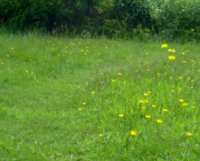 'Flowery hiccup' in my own garden. The results of no mowing for six weeks from mid-May. (View bigger image.)
The intriguing 'flowery hiccup' is an idea outlined by Chris Baines in his book How To Make a Wildlife Garden. The idea here is to stop mowing your lawn altogether some time during May and leave it uncut for anything from four weeks upwards (see the feature article The flowery hiccup). These latter two options allow you to discover what plants have survived in your lawn for years despite close mowing and will normally throw up pleasant surprises. Both, especially the short flowery lawn, can be successful on areas of medium fertility. The woodland glade is a 'meadow' type that can be tried in areas of medium fertility and damp shade (many gardens have areas like this) and is typified by shade tolerant grasses, sedges, blubells (Hyacynthoides non-scriptus), wood avens (Geum urbanum), primrose (Primula vulgaris), bugle (Ajuga reptans) etc. 'Flowery hiccup' in my own garden. The results of no mowing for six weeks from mid-May. (View bigger image.)
The intriguing 'flowery hiccup' is an idea outlined by Chris Baines in his book How To Make a Wildlife Garden. The idea here is to stop mowing your lawn altogether some time during May and leave it uncut for anything from four weeks upwards (see the feature article The flowery hiccup). These latter two options allow you to discover what plants have survived in your lawn for years despite close mowing and will normally throw up pleasant surprises. Both, especially the short flowery lawn, can be successful on areas of medium fertility. The woodland glade is a 'meadow' type that can be tried in areas of medium fertility and damp shade (many gardens have areas like this) and is typified by shade tolerant grasses, sedges, blubells (Hyacynthoides non-scriptus), wood avens (Geum urbanum), primrose (Primula vulgaris), bugle (Ajuga reptans) etc.
 Whatever kind of meadow you try for, expect the unexpected and above all, be prepared for change Whatever kind of meadow you try for, expect the unexpected and above all, be prepared for change Whatever kind of meadow you try for, expect the unexpected and above all, be prepared for change. Over the first few years and probably far beyond, your meadow will be a completely different beast from one year to the next: a dynamic, changing community. Whatever kind of meadow you try for, expect the unexpected and above all, be prepared for change. Over the first few years and probably far beyond, your meadow will be a completely different beast from one year to the next: a dynamic, changing community.
 We can just resolve to enjoy the changes and to accept a role as a custodian rather than 'master' of the meadow We can just resolve to enjoy the changes and to accept a role as a custodian rather than 'master' of the meadow No matter how well you assess your site, define your strategy and select your seed, some species will do worse than you expected and some better. Plant and animal communities are complex systems: we can never predict with absolute certainty what will happen from one year to the next. We can just resolve to enjoy the changes and to accept a role as a custodian rather than 'master' of the meadow. The meadow, its plants and its animals, will have a life all of its own. No matter how well you assess your site, define your strategy and select your seed, some species will do worse than you expected and some better. Plant and animal communities are complex systems: we can never predict with absolute certainty what will happen from one year to the next. We can just resolve to enjoy the changes and to accept a role as a custodian rather than 'master' of the meadow. The meadow, its plants and its animals, will have a life all of its own.
| First published June 2003. Last revised July 2006. | |
Copyright Richard Burkmar 2003. Permission is hereby granted for anyone to use this article for non-commercial purposes which are of benefit to the natural environment as long the original author is credited. School pupils, students, teachers and educators are invited to use the article freely. Use for commercial purposes is prohibited unless permission is obtained from the copyright holder. |
Back to home page
Do you live in Merseyside? Interested in its wildlife? | |